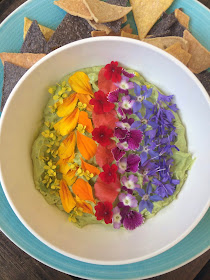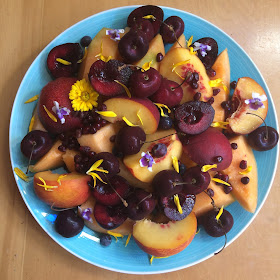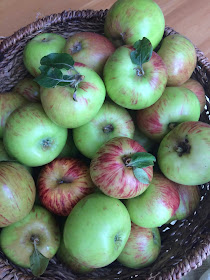In the past two month I have been taking lots of photos of my dishes, but posted very few recipes on the blog. Lack of time, yes, but I do cook every day, and not always new things, so it would be silly to repeat recipes. But one thing I can do is to change the appearance of food, especially in Summer, when fruit, vegetables and flowers abound. So here a few tips to make food more colourful!
Start easy, with desserts
Desserts are the easiest things to colour, naturally. Pictured above some creamy puddings, chocolate with ground pistachio, lemon or vanilla pudding with a drop of berry or cherry syrup and a strawberry, and blueberry pudding made by adding blueberry freeze dried powder to the vanilla puddings. Add edible flowers like dianthus or violets.
These desserts can be vegan or vegetarian, two vegan chocolate recipes are
here or
here
And
here you can find two vegetarian recipes for lemon and raspberry puddings (for blueberry follow the same method but add blueberry powder instead of raspberry powder).
Vanilla puddings are even easier, and you can start with a vanilla pudding and then move on and add other ingredients (like chocolate or fruit) and save time.
Here is the recipe.
Of course you can also layer the different flavours!
Cannot make dessert? Try fruit platters and edible flowers
In summer I do make the most of the edible flowers I grow in the garden, and these can be also used to add a special touch to fruit platters, like this (where I used verbena and dianthus with watermelon, nectarines, peaches, cherries, apricots, blueberries and pomegranate), and even if you cannot make desserts, or have no time, or are on a diet, you will always be able to impress guests with a fruit platter.
Here I used rock melon, nectarines, peaches, plums, cherries, pomegranate, calendula and violets.
For this one watermelon, nectarines, pink and purply plums, blueberries, cherries, pomegranate and verbena flowers.
And even if you don't have the time to cut fruit, presentation is all you need: here some plums presented with some cornflowers (also edible, btw).
Also effective to use the watermelon shell as a container for fruit salad, and serve on banana leaves, perhaps with banana flower petals, if you have them). Other leaves work well too, just wash them well first.
Just looking at the colours of fruit makes everyone happy, and if you are so pressed for time that you cannot even cut a fruit salad, a basket or two of fruit on the table will always make a good impression.
A touch of red or pink catches the eye
Next tip: make full use of colourful vegetables, radishes, for example, can be grated and used to decorate and flavour food. I had some hinari tofu pockets filled with rice and topped with mushrooms and greens, and a couple of radishes just added interest and colour.
The avocado sashimi is already colourful, but adding just one (always edible) flower brought out the green even more.
And a few petals (of impatiens) made this vegetarian sushi platter look less 'monocrome' - impatiens are good with savoury food, as they taste a little like rocket salad.
Flowers suit the style of Japanese cuisine, but if you don't have edible flowers at hand, or prefer not to use them, just cut a carrot slice like a flower: it will make all the difference.
Just one carrot slice can change the look of a dish, and in winter colourful Japanese pickles (plus your carrot slice) can brighten up boring white/beige food. Sorry about the bad photo though, it was evening and quite dark...
White brings out the other colours
White also helps: mozzarella, feta and other white cheeses bring out the colours in other vegetables. If you are in doubt of what to make, a caprese salad is always a good idea, here a two examples, a classic one and then one with different types of tomatoes, bocconcini, and different herbs (fresh oregano and thyme). More ideas can be found
here.
Green herbs do magic
Do you remember when all the food coming out of restaurants had a sprinkle of parsley? Well, that may had been OTT at times, but in some ways it does make sense. Fresh herbs are a life saver for brown food, and to give you an example (without parsley) I add chopped coriander to all my Mexican dishes. (fortunately I love it)! In the photo below, clockwise from top left: refried beans, jack fruit, tortillas, vegan chili (sans carne) and guacamole. Then you just need to add a green salads and tomatoes to assemble the tortillas, and you are done!
And then, every now and then I do something a bit more colourful (like the chili corn, capsicum and quorn dish below), just for the fun of having added colour, but this is for summer, when corn and capsicums are in season.
And of course for the guacamole you can also add a flower ...
... or several flowers! And cherry tomatoes too!
A few more ideas
Protein, even vegetarian protein, tend to be white/beige/brown, take almonds and other nuts for example (except for the green pistachio nuts), but with a little fruit powder, or berry juice, you can create a colourful display even with a single base ingredient (almond, in this case). Check out the recipe for this easy marzipan
here. And of course colourful paper cases help too!
Below I have a brown lentil salad, placed on a bead of mixed green leaves, and decorated with edible flowers, so easy, full of protein, plus it is vegan and gluten free, for the recipe just
click here, where you can also find a lot of other recipes using edible flowers.
The flower blog is
Cooking with Flowers and, although some of the recipes are raw, it mostly deals with actually using flowers in the kitchen and as important ingredients, not just as simple decorations. Click
here to view.
Photos and Recipes by Alessandra Zecchini ©







































